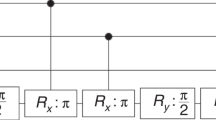Abstract
An allowable generalized quantum gate (introduced by Long, Liu and Wang) has the form of U = Σ d−1k=0 c k U k , where U k’s are unitary operators on a Hilbert space H and |Σ d−1k=0 c k |⩽1 and |c k |⩽1 (0⩽k⩽d−1). In this work we consider a kind of AGQGs, called restricted allowable generalized quantum gates (RAGQGs), satisfying 0 < Σ d−1k=0 |c k |⩽1. Some properties of the set RAGQG(H) of all RAGQGs on H are established. Especially, we prove that the extreme points of RAGQG(H) are exactly unitary operators on H and that B(H)=R + RAGQG(H).
Similar content being viewed by others
References
Long G L. The general quantum interference principle and the duality computer. Commun Theor Phys, 2006, 45: 825–844
Gudder S. Duality quantum computers and quamtun operations. Int J Theor Phys, 2008, 47: 268–279
Du H K, Wang Y Q, Xu J L. Applications of the generalized Luders theorem. J Math Phys, 2008, 49: 013507
Gudder S. Mathematical theory of duality quantum computers. Quant Inform Process, 2007, 6: 37–48
Long G L, Liu Y. Duality quantum computing. Front Comput Sci China, 2008, 2: 167–178
Wang Y Q, Du H K, Dou Y N. Note on generalized quantum gates and quantum operations. Int J Theor Phys, 2008, 47: 2268–2278
Long G L, Liu Y, Wang C. Allowable generalized quantum gates. Commun Theor Phys, 2009, 51: 65–67
Long G L. Mathematical theory of duality computer in the density matrix formalism. Quant Inform Process, 2007, 6: 49–54
Long G L, Liu Y. Duality computing in quantum computers. Commun Theor Phys, 2008, 50: 1303–1306
Zou X F, Qiu D W, Wu L H, et al. On mathematical theory of the duality computers. Quant Inform Process, 2009, 8: 37–50
Chen Z L, Cao H X. A note on the extreme points of positive quantum operations. Int J Theor Phys, 2009, 48: 1669–1671
He Y G, Sun J G. Complete quantum circuit of Haar wavelet based MRA. Chinese Sci Bull, 2005, 50: 1796–1798
Fang X M, Zhu X W, Feng M, et al. Realization of quantum discrete Fourier transform with NMR. Chinese Sci Bull, 2000, 45: 1071–1075
Liu D D, Di Y M. CM ⋇ CN D-computable state. Sci China Ser G-Phys Mech Astron, 2008, 51: 1300–1307
Ye M Y, Zhang Y S, Guo G C. Quantum entanglement and quantum operation. Sci China Ser G-Phys Mech Astron, 2008, 51: 14–21
Zhang Y, Cao H X, Li L. Realization of allowable generalized quantum gates. Sci China Phys Mech Astron, in press
Author information
Authors and Affiliations
Corresponding author
About this article
Cite this article
Cao, H., Li, L., Chen, Z. et al. Restricted allowable generalized quantum gates. Chin. Sci. Bull. 55, 2122–2125 (2010). https://doi.org/10.1007/s11434-010-3221-5
Received:
Accepted:
Published:
Issue Date:
DOI: https://doi.org/10.1007/s11434-010-3221-5



